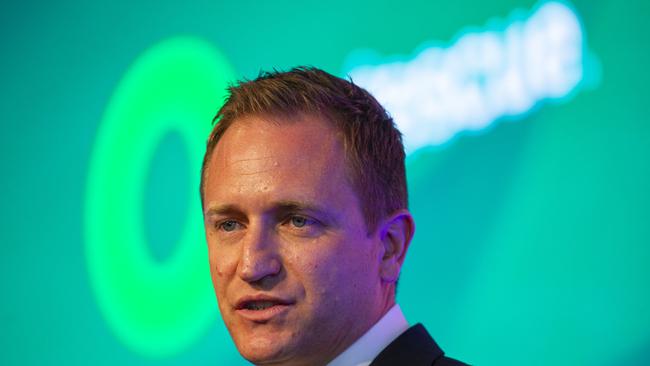Fortescue plugs green iron in the Pilbara after hydrogen job cuts
A costly hydrogen facility in Queensland’s Gladstone has been dumped. Now, Fortescue wants to deliver on its green iron dream to keep the Pilbara competitive against better grades coming out of Africa.

Fortescue boss Dino Otranto says investors have backed its retreat from hydrogen technology that underpinned its dumping of a Queensland electrolyser factory as it pivots to developing a major high-grade green iron industry to compete with Africa and Brazil.
The Andrew Forrest-backed Fortescue on Tuesday laid off about 90 staff working on its green hydrogen project, spread across its Queensland electrolyser facility and a hydrogen lab in Western Australia, in a fresh blow to hopes the nascent industry could eventually rival Australia’s gas export sector for size.
Mr Otranto told The Australian Fortescue abandoned plans to use the proton exchange membrane (PEM) electrolyser technology that Gladstone was predicated upon.
“We don’t believe that PEM is the right bet in this space, so we’re refocusing and redeploying those resources onto the technology for green iron that we’re working on in the Pilbara. We are absolutely doubling down on green iron and hydrogen. Unfortunately for those impacted in our business, it won’t be PEM for us,” Mr Otranto said.

The Fortescue boss said the company was now singularly focused on developing green iron in the Pilbara with hydrogen options, including in-house technology and “off the shelf” options acquired externally.
“The feedback we get from our shareholders is now we have a much clearer path to commercial viability of our energy business and metals business and they are actually applauding some of these decisions where we’ve sharpened the pencil in the space,” Mr Otranto said of the mood in the market.
Dr Forrest last year abandoned his ambitious green hydrogen targets in a major business backdown with hundreds of jobs cut after the iron ore mogul pulled back from a goal of producing 15 million tonnes of green hydrogen a year by 2030.
Fortescue is relying on technology breakthroughs as it contemplates building a commercial scale green iron plant in the Pilbara with the aim of boosting low-grade hematite supplies to high-grade green iron production to compete with output from Guinea and Brazil.
It is working on plans for a 1500 tonne a year pilot plant, but is exploring opportunities for an even bigger facility likely to need a multibillion-dollar investment.
Iron ore’s grade problem
The Fortescue boss conceded green iron was early stage but voiced confidence it was a bet that would give longevity to WA’s $117bn iron ore export jewel.
“We’re way too early for exporting boats out of Port Hedland on it. But the key prize - and I keep coming back to how existential this is for Australia - is showing that low grade iron ore has a future,” he said.
“You’ve got Vale, BHP, Rio all announcing that their grade is slipping. The only current commercial route to make green iron - which is what the Chinese want - is through Middle Eastern direct reduced iron, which is high grade out of Africa. It’s not where Australia participates. We need to change that.”
Fortescue hopes to produce high-purity green iron from its pilot plant at Christmas Creek with first supplies due by the end of 2025.
The iron ore giant originally proposed its Gladstone 15,000sqm advanced manufacturing facility in Queensland, constructed and fully commissioned in two years, with capacity to produce more than 2 gigawatts of proton exchange membrane electrolyser stacks annually.
What is electrolyser
Electrolysers split hydrogen and oxygen by passing an electrical current through water, which is made up of both molecules.
Last year BHP, Rio Tinto and BlueScope partnered in their efforts to accelerate the decarbonisation of steelmaking by agreeing to jointly investigate the development of the country’s first ironmaking electric smelting furnace pilot plant.
Fortescue in December 2024 vowed it will be producing green iron from a pilot plant in Western Australia before its bigger rivals BHP and Rio Tinto have even worked out whether to push ahead with their own version.
Fortescue in March axed an investment pact with US hydrogen giant Plug Power, as developers pulled back from projects following the election of Donald Trump.
It signalled the latest challenge by the nation’s most prominent cheerleader for green hydrogen, with Dr Forrest only a few years ago boasting that the company’s green-energy ambitions would one day make it bigger than the world’s biggest oil producer, Saudi Aramco.




